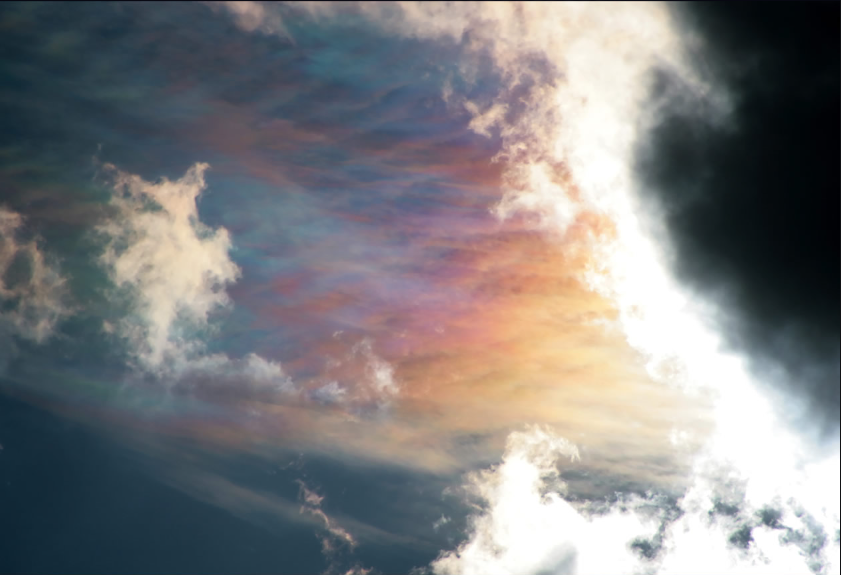OPOD - Intense Iridescence
OPOD - Intense Iridescence: A Captivating Atmospheric Phenomenon
Have you ever witnessed a mesmerizing display of multicolored clouds? Phillip Bonn, a resident of central NY State, was fortunate enough to capture such a spectacle. He was so captivated by the interesting cloud formations that he kept his camera handy, pulling over frequently to document the breathtaking scenes. The iridescence he observed was truly spectacular and abundant, especially when the sun was hidden behind a cloud.
The vibrant colors that adorned the clouds were not a mere coincidence; they were the result of a fascinating optical phenomenon known as diffraction. The small droplets present within the clouds played a crucial role in scattering light waves, giving rise to this enchanting display of colors. Each droplet's surface acts as a source of outgoing spherical waves, which then interact with one another. In areas where the wave crests coincide, bright light is produced, while areas where the crests cancel out appear darker. The collective effect of millions of similarly sized droplets in the sky creates a circular diffraction or interference pattern, commonly referred to as a corona.
However, when the cloud droplets vary in size across different parts of the cloud, the diffraction pattern becomes less ordered. Instead of well-defined coronal rings, we observe a chaotic blend of multiple colors. This occurs when droplets in a specific area exhibit a wide range of sizes or when the cloud is thick enough to allow for multiple scattering to take place. In such cases, the corona and iridescence are no longer visible to the observer.
It's important to note that the appearance of intense iridescence can vary depending on several factors. The size distribution of the droplets within the cloud plays a significant role in determining the nature of the diffraction pattern. When the droplets are more uniform in size, the resulting corona tends to exhibit clearer and more distinct rings of colors. On the other hand, a wider range of droplet sizes leads to a more chaotic and vibrant display of colors, with overlapping and blending hues.
The thickness of the cloud also influences the visibility of iridescence. In thinner clouds, where the light can easily penetrate through, the corona may appear more defined and vivid. However, in thicker clouds, multiple scattering occurs, causing the light to bounce around between droplets. This phenomenon diminishes the appearance of a corona and iridescence, resulting in a less pronounced display of colors.
To truly appreciate the beauty of intense iridescence, it is essential to have the right conditions. A combination of uniform droplet sizes and a thinner cloud layer can create a breathtaking spectacle in the sky. These captivating displays serve as a reminder of the intricate interactions between light and matter in our atmosphere.
In conclusion, intense iridescence is a captivating atmospheric phenomenon that occurs when light waves interact with cloud droplets through diffraction. The resulting display of colors can range from well-ordered coronal rings to chaotic blends of vibrant hues, depending on the size distribution of the droplets and the thickness of the cloud. Observing these mesmerizing scenes reminds us of the beauty and complexity present in our natural world. So keep your eyes on the sky, for you never know when you might witness the enchanting dance of intense iridescence.

Intense Iridescence
Phillip Bonn saw these multicoloured clouds in central NY State. "There were so many interesting cloud formations that I just kept the camera handy and pulled to the side of the road frequently. The iridescence was spectacular and plentiful once the sun was hidden behind a cloud." ©Phillip Bonn, shown with permission.

The colours are the result of diffraction by small cloud droplets.
The droplets scatter light waves mainly from their surface.�Each surface point is a source of outgoing spherical waves.�The waves interact with each other and in directions where wave crests coincide there is bright light.� Where the crests cancel there is darkness.�The result in the sky from millions of same sized droplets is a circular diffraction or interference pattern � a corona.
Things change when the cloud droplets have different sizes in different parts of the cloud. Diffraction still occurs but we see a many coloured jumble rather than well ordered coronal rings.
When the droplets in one area have a wide range of sizes or the cloud is thick enough for multiple scattering to occur then we no longer see any corona or iridescence.


Note: this article has been automatically converted from the old site and may not appear as intended. You can find the original article here.
Reference Atmospheric Optics
If you use any of the definitions, information, or data presented on Atmospheric Optics, please copy the link or reference below to properly credit us as the reference source. Thank you!
-
<a href="https://atoptics.co.uk/blog/opod-intense-iridescence/">OPOD - Intense Iridescence</a>
-
"OPOD - Intense Iridescence". Atmospheric Optics. Accessed on December 19, 2024. https://atoptics.co.uk/blog/opod-intense-iridescence/.
-
"OPOD - Intense Iridescence". Atmospheric Optics, https://atoptics.co.uk/blog/opod-intense-iridescence/. Accessed 19 December, 2024
-
OPOD - Intense Iridescence. Atmospheric Optics. Retrieved from https://atoptics.co.uk/blog/opod-intense-iridescence/.